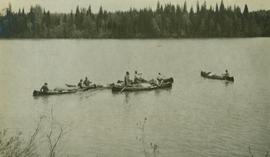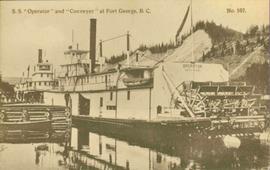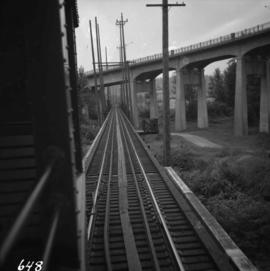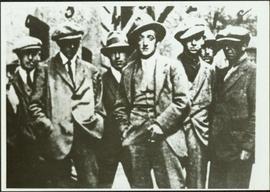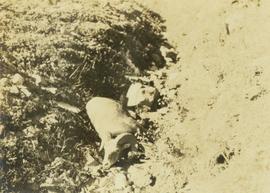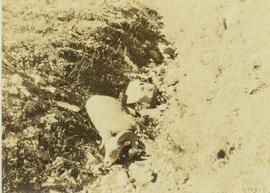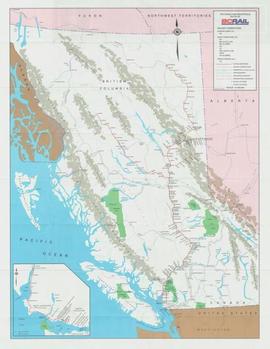File consists of a publication by Henry Ewert entitled "The Story of the B.C. Electric Railway Company".
"The Story of My Life" is a DVD that was made for Audrey Ruth Smedley L'Heureux's 80th birthday. The video starts with Audrey's parents, Marion Lucy Auld Spencer Graham (mother) and (father) Bert Spencer. The beginning of the video detailed pre-war life in Vanderhoof and the struggles that Audrey's parents had while raising their three children Audrey, Pat, and Jim Spencer. Audrey later goes on to marry Jack Smedley and moves to the Smedley farm for a short time; the Smedley farm is sold in 1957 and later becomes the Vanderhoof Products & Timber Ltd. headquarters. Before leaving the farm, Jack and Audrey had three children together: Albert Smedley, Georgina Becker, and Teddy Smedley. Jack and Audrey divorced on August 26, 1969. Audrey describes her divorce as a freeing experience that allowed her to start her journey in journalism. For a brief time Audrey owned the Nechako Chronicle but sold it in 1971. After a short stint as a photojournalist at the Langley Advance, Audrey became an editor of the Interior News for a year then moved to the Ingot (Alcan) in Kitimat to become their editor. Audrey's industry experience allowed her to expand her field of research leading her to move to Smithers and Prince George. Audrey and Edmond Joseph L'Heureux married in August 12, 1971. Edmond and Audrey welcomed in seven grandchildren. Edmond L'Heureux died in 2001. The video ends with the awards and accomplishments given to Audrey L'Heureux, including her 1998 Community Booster of the Year award from the Vanderhoof Chamber of Commerce and her 1997 appointment to the Seniors Advisory Council of British Columbia.
A Journey into the Upper Peace River Country
Stern wheelers “Operator” and “Conveyor” in dock. Printed annotation on recto reads: “S.S. “Operator” and “Conveyer” at Fort George, B.C. No. 107.”
File consists of "The Spruce Needle" newspaper, vol. 1 no. 6 (21 Sept. 1982). The serial described itself as having "Prince George Community News and Views".
File consists of "The Spruce Needle" newspaper, vol. 1 no. 5 (14 Sept. 1982). The serial described itself as having "Prince George Community News and Views".
File consists of "The Spruce Needle" newspaper, vol. 1 no. 4 (7 Sept. 1982). The serial described itself as having "Prince George Community News and Views".
File consists of "The Spruce Needle" newspaper, vol. 1 no. 3 (31 Aug. 1982). The serial described itself as having "Prince George Community News and Views".
File consists of "The Spruce Needle" newspaper, vol. 1 no. 2 (24 Aug. 1982). The serial described itself as having "Prince George Community News and Views".
File consists of "The Spruce Needle" newspaper, vol. 1 no. 1 (17 Aug. 1982). The serial described itself as having "Prince George Community News and Views".
Photograph depicts the split of the Great Northern Railway (GNR) (shown) and the Canadian National Railway (CN) tracks, immediately south of the Fraser crossing at New Westminster.
Postcard depicts spiral tunnels near Yoho National Park, BC
File consists of a book by Graeme Pole entitled "The Spiral Tunnels and the Big Hill: A Canadian Railway Adventure".
Postcard depicts 'The Spiral Tunnels."
Postcard depicts a spiral tunnel near Field B.C. Mount Stephen visible.
Photograph depicts a group of seven men standing in front of buildings. This is believed to be a cropped copy print of an original photo of the erroneously entitled the "Cairo Gang." Handwritten annotation on verso of photo reads: “Members of IGOE Gang. These were a group of police spies under the leadership of a fearless R.I.C. officer who were brought in from country posts to identify volunteers who would come in from Command Post in the country to visit H.Q. Dublin.” This annotation may be incorrect; instead, the photograph may depict members of the Special Gang "F" Coy. Auxiliary.
Item is an original "The Spatsizi and Stikine Rivers: Mainstem System Evaluations of Fishery and Recreation Values" by E.J. Osmond-Jones, Environmental Management Division, B.C. Parks Branch. Includes original photographic prints pasted into the report.
File consists of the anthology "The Sound of a Train in the Distance: Puffing, Whistles, and Roars of Multicultural Pedagogy".
Photograph depicts the Soda Creek cemetery.
Consists of reproduced archival material collected from the Smithsonian Institution in order to facilitate regional access to records.
File consists of issues of the literary periodical entitled "The Smith", including issue 8.
Habit of <i>Prunus</i> in autumnal foliage, Prince George, British Columbia
Prince George, B.C.
Alpine Club of Canada's 1967 Yukon Alpine Centennial Expedition, Kluane National Park, Yukon
File consists of a book by Robert D. Turner and David S. Wilkie entitled "The Skyline Limited: The Kaslo and Slocan Railway--Narrow Gauge Railroading and Sternwheelers in the Kootenays".
Red and yellow light against cloud filled sky. Vancouver, British Columbia
File consists of a spiral bound booklet titled "The Sir Alexander Mackenzie 'Canada Sea-to-Sea' Bicentennial Expeditions" prepared by Alexander Mackenzie Committee.
File contains a publication documenting Royal Visit to Canada from October 14 – 19, 1977. Features a photo of Iona Campagnolo with Her Majesty Queen Elizabeth watching The Silver Jubilee Regatta in Ottawa (p. 17).
File consists of a set of 5 bound volumes entitled "The Shoulder Strap – Official Journal of the British Columbia Provincial Police", which was a popular magazine detailing police force life from the 1920s-1950s.
File contains a manuscript of "The Sexual Detective: A Narrative", which is an early draft of "Gender Wars".
File consists of a 3.5-inch floppy disk containing Brian Fawcett's digital records.
Man and woman eating chicken upon wooden crates
File consists of two copies of "The Sekani Indians of British Columbia" by Diamond Jenness. The documents were created by the Canadian Department of Mines and Resources.
File contains clippings, notes, periodicals, and correspondence relating to Alexander Mackenzie research.
File contains a notebook with notes for "The Secret Journal of Alexander Mackenzie".
File contains a final draft manuscript of "The Secret Journal of Alexander Mackenzie" short story anthology.
Subseries contains draft manuscripts of short stories included in the "Secret Journal of Alexander Mackenzie" short story anthology. Also includes a published edition of the work and research notes.
File contains a published edition of "The Secret Journal of Alexander Mackenzie".
Vertical perspective of mountain climbers, Alpine Club of Canada trek?
File consists of a publication by Eric L. Johnson entitled "The Sea-to-Sky Gold Rush Route: A Guide to the Scenic Railway of the White Pass".
File consists of notes and a draft titled "The Search for Advice."
Map depicts the route of BC Rail and its connecting rail lines.
Campsite, Alpine Club of Canada's 1967 Yukon Alpine Centennial Expedition, Kluane National Park, Yukon
Glass slide depicts a Jewish high priest and one other man preparing a sacrificial goat in front of a smoking altar. Annotations include hand written, "S.E. 22. The Scapegoat" and printed on stamp, "(COPYRIGHT) FROM "THE ILLUSTRATED BIBLE" NEWTON CO. MAKERS 3 FLEET ST LONDON"
File consists of issues of "The Sandhouse", the journal of the Canadian Railroad Historical Association Pacific Coast Division. Contains various complete issues relating to multiple railway subjects. Also includes miscellaneous excerpted articles from Sandhouse issues.
File consists of a photocopy of a handwritten essay titled "The Sale of the Fort George Indian Reserve #1" by Jason B. Llewellyn.
The Sailor - Bishop, or The Life of Bishop William Ridley. Church Missionary Society. 1913.
File consists of a speech given by Gary Runka entitled "The Rural-Urban Continuum: Tough Land Use Choices Ahead" for the Vernon Rotary Rural-Urban Day.
Commentary on this speech by Barry Smith of the Ministry of Agriculture and Lands:
"This speech / paper does cover some old ground dealt with in other speeches but is nicely brought together here.
GGR outlines several competing land uses and uses agriculture as a starting point in setting the stage by noting that there are just 74,400 food producers and 2,400,000 other British Columbians.
An emphasis is placed on communications, especially since most planners and politicians are overwhelmingly urban oriented. When involved with rural planning it is important to understand the rural side of the fence and look back at the urban area rather than the other way around. This means "understanding the natural characteristics of the land resource and its ecosystems."
Seven issues are considered:
- Short-sighted premises - the supply of land is limitless and the individual has the right to use his
land as he wishes without affecting others; - The interdependence of man within natural systems is not fully appreciated;
- Reluctance of rural people to accept planning programs;
- Institutions and organizations reflect rural reality;
- Sprawl is not confined to urban areas and when it affects the rural area it can be a large problem;
- The dilemma of wanting data to make good land use decisions, but while we wait for information,
bad decision are being made; and - What is politically palatable?
The speech ends with the need for rural and urban communities to be mutually supportive. While farmland preservation isn't central to this speech the rural resource and planning theme is relevant."
